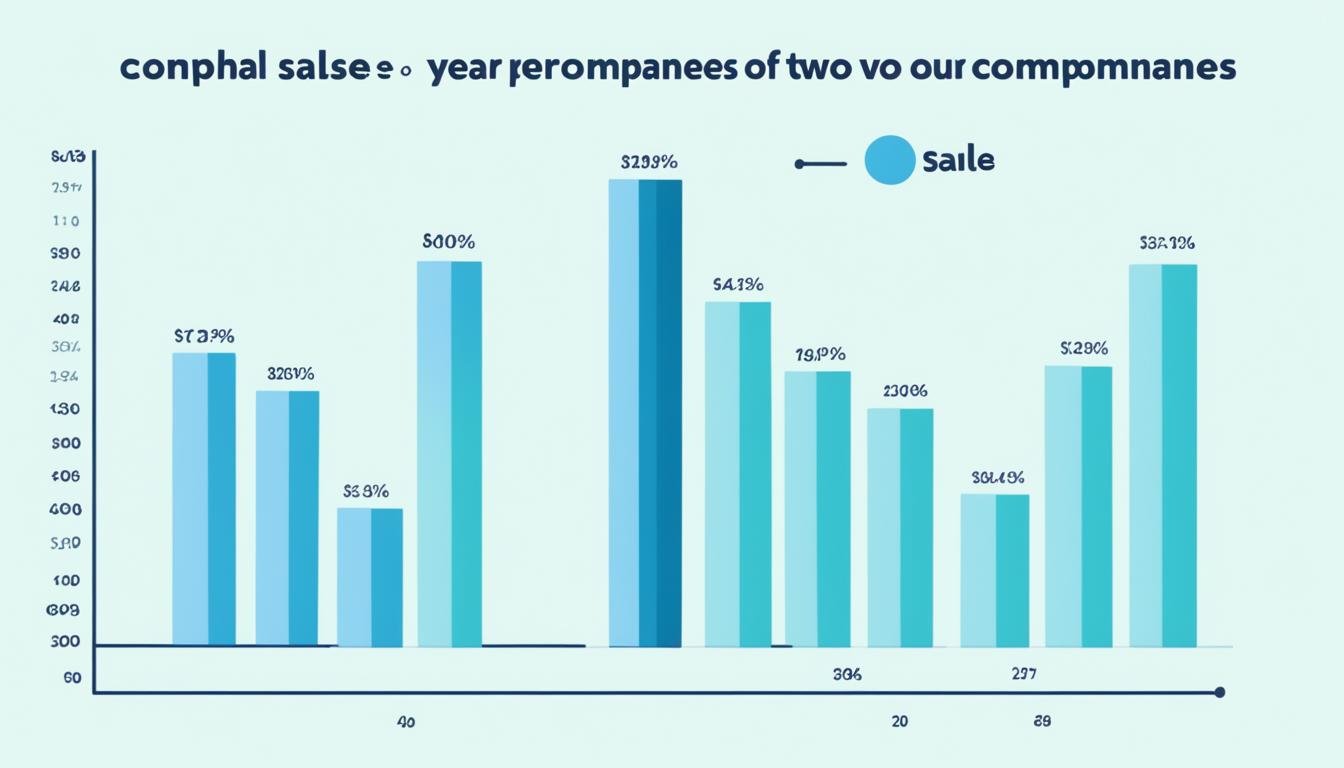Sales Benchmarking: Comparing Performance
In today’s world, knowing if your sales are top-notch is key. The answer is in sales benchmarking. This means comparing your sales methods, numbers, and outcomes to what others in your field do best. But what steps do you need to take to find the insights that boost your sales?
Key Takeaways
- Sales benchmarking helps organizations check how they’re doing in sales and spot areas to get better.
- By comparing sales metrics to what others in your field do, you can find new chances to grow.
- Good sales benchmarking means picking the right metrics, getting accurate data, and understanding the results well.
- Using sales benchmarking insights, businesses can make their sales better, improve sales enablement, and increase revenue.
- It’s important to keep an eye on and adjust your sales benchmarks to stay ahead in the market.
What is Sales Benchmarking?
Sales benchmarking is a key strategy for businesses. It lets them see how they stack up against others in the industry. By looking at important metrics and analyzing the data, companies can find ways to get better and grow.
This approach helps businesses stay ahead, work more efficiently, and increase their sales over time.
Defining Sales Benchmarking
Sales benchmarking means checking how well a company does against certain Key Performance Indicators (KPIs) and Sales Metrics. It’s done by looking at competitors or by seeing how they match up with Industry Standards and Best Practices.
The main aim is to spot what’s going well, what needs work, and where there are chances to do better. This leads to better Sales Enablement, Data Analytics, and Sales Optimization.
Benefits of Sales Benchmarking
- Enhances Comparing Performance and identifies areas for improvement
- Provides insights into industry trends and Competitive Analysis
- Helps set realistic Sales Metrics and Revenue Growth targets
- Facilitates the adoption of Best Practices and Industry Standards
- Enables data-driven decision-making and Sales Enablement
- Supports the development of effective Sales Optimization strategies
By using sales benchmarking, companies can make smart choices. They can improve their sales methods and beat their competitors in the market.
The Process for Benchmarking Sales Performance
Using industry benchmarks is key to improving sales performance. This process has three main steps: picking the right benchmarks, getting the right data, and understanding the results.
Select the Right Benchmarks
The Alexander Group offers a wide range of metrics for sales benchmarking. These include productivity, time, deployment ratios, investment, readiness, compensation, and specific practices for each industry. By matching these KPIs with your goals, you can see how your sales team stacks up against others.
Obtain the Right Data
Good sales analytics and benchmarking need accurate data. The Alexander Group checks and cleans their data carefully. This ensures the data is reliable, helping companies make smart choices for sales optimization and revenue growth.
Interpret the Results
Understanding the data means knowing the sales world and your company’s specific situation. The Alexander Group’s experts use their deep knowledge to find important insights. This helps businesses spot areas to improve, set achievable goals, and use sales enablement strategies well.
With sales benchmarking, companies can get ahead, make better decisions with data analytics, and boost their sales performance.
Why Sales Benchmarking Works
Sales benchmarking helps businesses see how they stack up against others in their field. It lets them check their sales against Key Performance Indicators (KPIs) and top competitors. This way, they can learn from the best and make smarter choices.
It’s great for finding out why some companies do better than others. By looking at the numbers, businesses can spot areas to improve. This leads to better sales and more money coming in. Plus, it helps them copy the best strategies, no matter where they come from.
This method is all about using facts to make decisions. It’s based on solid data and has a history of working well. It also fits with new ways of managing like Business Service Management (BSM). This makes it a key tool for leaders wanting to boost their sales and use data better.
In short, sales benchmarking is powerful because it helps businesses compare themselves, set goals, and make smart choices. By using it, companies can reach their full potential and stay ahead in the market.
Sales Benchmarking: Comparing Performance
Sales benchmarking helps businesses check how they’re doing against others and their own past. It looks at things like sales cycle length, sales conversion rate, sales productivity rate, average deal size, and revenue growth. This gives companies insights to improve their sales.
Using sales benchmarking makes decisions smarter. It moves away from just guessing or looking at past numbers. With sales benchmark data, companies can pick the best sales strategies and use their resources wisely. This leads to better sales and more money made.
Choosing the right Key Performance Indicators (KPIs) and Sales Metrics is key. Also, getting good data for Competitive Analysis and Comparison to Industry Standards is important. By doing this, companies can see what’s working in their Sales Enablement efforts. They can find ways to use Data Analytics for better Sales Optimization.
“Sales benchmarking is a critical component of any successful sales strategy. It allows us to identify areas for improvement, set realistic targets, and stay ahead of the competition.”
Sales benchmarking gives a clear view of a company’s sales performance. By keeping an eye on these Key Performance Indicators, businesses can make smart choices. This leads to steady Revenue Growth and keeps them leading in the market.
Benchmarking Basics
Benchmarking is a key strategy used by businesses today. It means comparing how an organization does things against the best in the industry. This helps companies find new chances to grow, see where they can get better, and keep making their sales operations better.
Why is Benchmarking so Popular?
Benchmarking is loved because it really helps improve how things work in many areas. It’s a great way to change things for the better. It makes people think differently and looks at how others do things, helping to make changes easier.
What does Benchmarking Deliver?
- Awakens a competitive drive and a desire to excel
- Discloses hidden links between processes and results
- Stimulates an objective review of practices, systems, and metrics
- Provides evidence to support business cases for change
- Helps overcome barriers to the adoption of new initiatives
“Benchmarking is considered one of the best ways to ensure proper business growth.”
By looking at their sales and comparing it to others, companies can find out what works best. They can see where they can do better. This helps with making sales better and growing revenue through data and smart strategies.
How to Benchmark Sales
Start by setting clear goals and picking the right metrics to track. Important KPIs like revenue, conversion rate, and customer satisfaction help measure sales performance.
You can use different methods for benchmarking, like comparing to your own company or to competitors. Internal benchmarking looks at your team’s performance against your company’s standards. External benchmarking sees how you match up against others in your industry.
Define Objectives and Metrics
First, make sure your sales goals align with your business aims and what you want your sales team to achieve. Pick metrics that are easy to measure and important for your goals.
Choose Benchmarking Method
You have options for benchmarking. Historical benchmarking looks at your sales over time. Functional benchmarking compares your sales methods with others in different industries.
Collect and Analyze Data
Get the right data for your benchmarking. Use tools like graphs and charts to spot areas where you can do better.
Compare and Evaluate Results
Look at your sales data against others in your field or your own past performance. Use a SWOT analysis to find out what you’re good at, what you need to work on, and what challenges you face. This helps you make a plan for improvement.
Implement and Monitor Actions
Make the changes you need and check how you’re doing against your goals. Use methods like SMART or HEART to track progress. Regularly review your sales benchmarking to keep improving and grow your revenue.
By following these steps, you can use sales benchmarking to make your sales strategies better, work more efficiently, and stay ahead in the market.
Leveraging Sales Benchmarking Data
Using sales benchmarking data can change the game for businesses looking to boost their sales. By comparing their sales with industry standards and top competitors, companies can spot areas to improve. This helps them make smart choices.
Companies spend about $15 billion a year on training sales reps and another $800 billion on incentives. Sales leaders use benchmarking to make choices based on data. This helps them hire the best sales talent and understand the market better.
Xactly’s Benchmarking tool, for example, uses over 14 years of data to help businesses with hiring and market decisions.
In retail, important benchmarking metrics include sales per square foot and customer satisfaction. By using these metrics, retailers can set goals and improve their performance. This helps them stand out in the market.
“Effective sales organizations leverage benchmarking to make strategic decisions, ensuring they are well-positioned against their competition.”
A recent Xactly survey found that companies spend at least 10% of their revenue on sales compensation. By looking at this data, sales leaders can improve their incentive plans. This can lead to more revenue growth.
Using sales benchmarking data can help improve sales productivity and guide strategic decisions. It’s a key tool for growing revenue and staying ahead in the market.
Conclusion
Sales benchmarking is a key tool for businesses to improve their sales and grow. It helps them see where they stand compared to others in the industry. By looking at their sales and how they stack up, companies can find areas to get better.
They can then make plans and use data to make smart choices. This helps them stay ahead of the competition. Whether it’s making sales more efficient, training staff better, or entering new markets, sales benchmarking gives the insights needed.
By analyzing competitors and following industry standards, businesses can find ways to improve their sales. They can learn from top performers and use their strategies. Data analytics is key in tracking progress and seeing how well they’re doing.
Using sales benchmarking regularly helps companies make better decisions. It helps them improve their sales and beat their competitors. By using this tool, businesses can stay ahead and make the most of the changing sales world.
Source Links
- Compare and Conquer: 12 Types of Benchmarking for Measuring Success | Databox
- 8 Steps of the Benchmarking Process
- Sales Benchmarking – Why, What, and When We Watch – Toolyt
- Sales Performance Benchmarking: Evaluating Same Store Sales – FasterCapital
- Company Benchmarking: Best Practices and Benefits
- How To Benchmark Sales
- Sales Benchmarking Methodology | How to Benchmark Sales
- How can benchmarking help your sales strategy
- Benchmarking in Business: What It Is & It’s Importance | Paychex
- What Is Benchmarking and Why Is It Important for Your Business? | Mailchimp
- Using Sales Benchmarks to Evaluate Sales Performance
- What are the best ways to benchmark sales team performance?
- What Is Benchmarking? How To Set Benchmarks (2023) – Shopify
- Benchmarking 101: Definition, Types, Benefits and How to Use Them
- What is performance benchmarking? – Talkwalker
- Benchmarking Metrics that Really Matter: Key Performance Indicators to Watch
- Benchmarking In Business: How To Improve Performance and Increase Profit
- Performance Benchmarking: A Quick Guide | SafetyCulture
- The Value of Benchmarking in Sales
- From Data to Insights: A Beginner’s Guide to Effective Benchmarking Analysis
- Sales Rep Performance Benchmarking: What Is It, and Why Is It Valuable? | People.ai
- Sales benchmarking: How to benchmark your sales performance against your competitors and industry standards – FasterCapital
- The Power of Benchmarking: Unlocking Insights for Business Growth
- What Is Benchmarking? Uses and Benefits in Business







